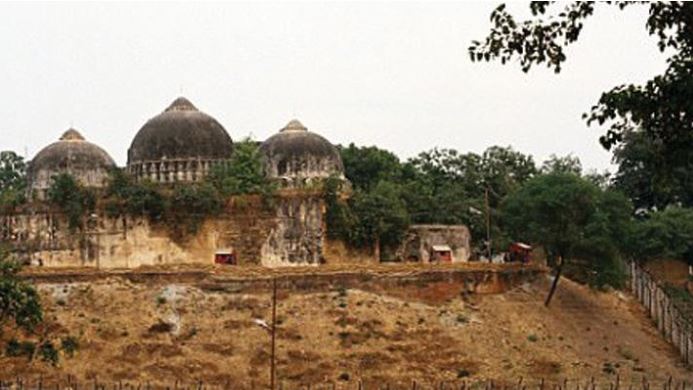New Delhi: A “massive” temple of Lord Ram, dating back to the second century BC (Before Christ), existed at the disputed site in Ayodhya before the construction of Babri Masjid, a counsel for deity “Ram Lalla Virajman” told the Supreme Court on Friday.
The counsel for Ram Lalla, a party to the decades-old Ram Janmabhoomi-Babri Masjid land dispute, referred to the report of a court commissioner, appointed to inspect the site in 1950, and also relied upon the findings of the Archeological Survey of India (ASI) to buttress its claim over the disputed 2.77-acre land in Uttar Pradesh’s Ayodhya.
Advancing submissions before a five-judge Constitution bench headed by Chief Justice Ranjan Gogoi on the seventh day of the hearing, senior advocate C S Vaidyanathan, appearing for the deity, said according to the ASI report, there “existed a massive, pillar-based structure dating back to the second century BC and the ASI survey was conclusive about there being a ‘mandap’ at the site with pillars”.
The senior lawyer extensively referred to various pictures and reports, including the ASI’s findings on the excavated materials from the disputed site, and said, however, there was no such material to show that it was a temple of only Lord Ram.
But the pictures of the deities, including those of Lord Shiva, sculptures on the pillars of “Garuda” flanked by lions and the images of lotus amply indicated that it was a temple and moreover, these things were not found in mosques, Vaidyanathan submitted before the bench also comprising justices S A Bobde, D Y Chandrachud, Ashok Bhushan and S A Nazeer.
“Keeping in mind the faith of Hindus and preponderance of probability, it would indicate that this was a temple of Lord Ram,” he said.
“Along with the massive old structure, other materials found during excavation suggested that it was a temple,” the senior lawyer added.
Referring to the Allahabad High Court order, he said one of the judges, Justice S U Khan, did not deal with the ASI report in his judgment and erroneously concluded that the mosque came up on a vacant land and on the ruins of a temple, while the other two judges took note of the report, which said there was a temple where the mosque came up.
“We are deriving support from the archeological evidence that from the second century BC, there was a temple and additions were made during different periods” namely during the rules of the “Shungas”, the “Kushans” and the “Guptas”, Vaidyanathan said.
“The question before us is not about the structure but whether it was of religious nature before the mosque was built there,” the bench said.
It also said during the course of civilisation, buildings were “built and rebuilt” and proofs were needed to establish that there was a temple where the mosque came up.
“It was a temple where the public had access. The basic foundation was the same, while the structure was rebuilt. The underlying foundation never changed. There was a total of 17 rows of pillar bases and each row had five pillars,” Vaidyanathan said.
Referring to the ASI’s 2003 report, he said it was prepared by experts and “there is nothing to discredit” its findings.
“You also have a grave here. How would you interpret this,” the bench asked.
“The grave belonged to a much later period,” the senior lawyer said, adding that there were several layers of excavations and the grave was not found during the deep excavation.
Vaidyanathan said archeological experts from both sides were present during the excavations, which were video-graphed, conclusions were arrived at after deliberations and “distinctive features of a temple” were found in the report.
“Huge pillared-halls, different from normal residential buildings, have been found in the ASI’s report,” he said, adding that excavation was not done of the place where the deity, “Ram Lalla Virajman”, was presently placed in the makeshift temple.
Vaidyanathan said the ASI analysed the excavated materials by dividing those into different time zones ruled by different dynasties.
At the outset, the senior lawyer referred to the report of a court-appointed commissioner, who had annexed various photographs of pillars containing images of Hindu gods.
He also submitted an album containing photographs of deities inside the structure and said mosques did not have such images inside them.
On the issue of “namaz” being offered at the disputed site in the past, Vaidyanathan said offering prayers did not mean a valid possession of the place.
“Offering prayers cannot mean valid possession unless you already own it. If prayer is offered on the street, it cannot be a proof to own it,” he said.
The bench said the question was whether the disputed structure was “built as a mosque or being used as a mosque”.
“No mosque will ordinarily contain pillars of this nature,” the lawyer said.
He said during the 1950 inspection itself, it was very clear that there were various “structures, images” that belied the claim that it was a mosque.
The advancing of arguments would continue on Monday.
Fourteen appeals have been filed in the apex court against the 2010 Allahabad High Court judgment, delivered in four civil suits, that the 2.77-acre disputed land in Ayodhya be partitioned equally among the three parties — the Sunni Waqf Board, the Nirmohi Akhara and “Ram Lalla Virajman”.
Babri Masjid was demolished by right-wing activists on December 6, 1992 in Ayodhya, leading to the protracted legal battle. (PTI)





